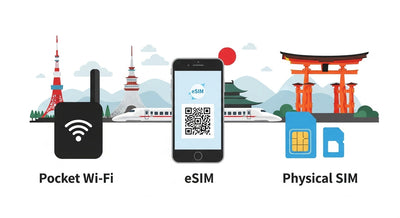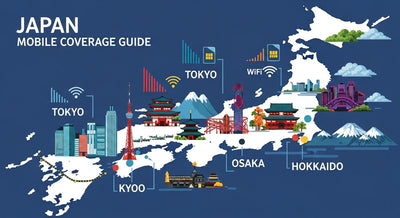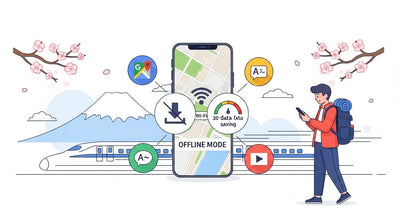Planning your trip to Japan and stuck on the big question: Do you actually need unlimited data?
It’s a dilemma many travelers face. On one hand, unlimited sounds safe—no worries about running out in the middle of Tokyo. On the other hand, unlimited often costs more, and you may end up paying for capacity you’ll never use.
This guide will break it down. By the end, you’ll know:
- What type of traveler really benefits from unlimited
- How much data you’re likely to use based on travel style and trip length
- Quick wins to reduce usage without ruining your experience
- How to confidently choose the right JP-SIM plan for your budget
Let’s dive in.
Why the “Unlimited” Myth Persists
Unlimited feels comforting. No calculations, no risk. But here’s the truth: most Japan trips don’t need it.
Travelers often overestimate their daily data use. Unless you’re tethering a laptop, constantly uploading videos, or sharing your hotspot with friends, capped plans often give more than enough breathing room. And with smart settings, you can stretch a 5GB or 10GB plan surprisingly far.
So before you default to the “unlimited” checkbox, take a moment to ask: What do I actually do online when traveling?
Who Should Actually Choose Unlimited?
There are three clear traveler profiles where unlimited makes sense:
-
The Social Media Creator
- Daily Instagram reels, TikTok uploads, or YouTube vlogs
- High-quality video takes a lot of data—up to 1–2GB per day if uncompressed
-
The Mobile Worker
- Tethering a laptop for Zoom meetings or cloud file transfers
- Work apps eat data quickly, especially video calls
-
The Group Hotspot Sharer
- Families or friends relying on one phone’s hotspot
- Multiple devices = multiplied usage
If you fit one of these, unlimited is the stress-free choice. For everyone else? Keep reading.
Realistic Data Usage Cheat Sheet
Here’s a rough guide to what common travel behaviors cost in data per day:
- Maps (Google Maps, Apple Maps): ~50MB
- Messaging (LINE, WhatsApp, Messenger): ~10–30MB
- Web browsing & travel research: ~100MB
- Photo uploads (medium quality): ~200–400MB
- Video streaming (YouTube/Netflix 480p): 500MB–1GB per hour
- Video uploads (TikTok, IG Reels): 300–500MB per video
Multiply that by your daily habits, and you’ll see why most casual travelers only use 0.5–1.5GB per day.
Data Needs by Trip Length × Travel Style
1–3 Day Weekend Trip
- Light Traveler (maps, chat, casual photos): ~1GB total
- Social Explorer (daily posts, stories): ~3GB total
- Power User (video uploads + laptop tethering): ~10GB+
7 Day One-Week Trip
- Light Traveler: 3–5GB
- Social Explorer: 7–10GB
- Power User: 20GB+
14+ Day Extended Trip
- Light Traveler: 7–10GB
- Social Explorer: 15–20GB
- Power User: 40GB+ or Unlimited
📊 Takeaway: If you’re a typical tourist using maps, chat, and occasional social posts, a 5GB–10GB plan easily covers a week. Unlimited is overkill unless you fall into the heavy-use categories above.
Quick Wins: How to Save Data in Japan
Even if you’re worried about overusing, there are easy tricks to cut data use without sacrificing convenience.
1. Download Offline Maps Before You Go
Both Google Maps and Apple Maps allow offline downloads. A Tokyo map is ~500MB, but then navigation is nearly data-free.
2. Reduce Social App Quality
Instagram, TikTok, and LINE default to high-quality uploads. Switch to “data saver mode” and you’ll cut consumption by half.
3. Turn Off Autoplay & Background Refresh
Apps like Facebook, Twitter (X), and YouTube auto-play by default. Disable it and stop wasting hundreds of MBs per day.
4. Use Hotel Wi-Fi for Big Uploads
Save your reels, then upload them when you’re back at the hotel Wi-Fi.
🔗 See detailed step-by-step app settings here → Save Your Data Abroad: Smart Settings for Maps, Translate, and Video
Cost Efficiency: Why Capped Plans Often Win
Unlimited might seem simple, but here’s the kicker: it usually comes at a higher daily rate.
Example:
- Unlimited Plan: ¥4,500 for 7 days (~¥640/day)
- 10GB Plan: ¥2,800 for 7 days (~¥400/day)
If you’re a light traveler using ~5GB in a week, you’re effectively paying 60% more for unused capacity. Multiply that across two weeks or a family trip, and the savings really add up.
The Compatibility Question
Before you even pick a plan, make sure your phone supports eSIM in Japan.
- Most iPhones from XS (2018) onward are compatible
- Most premium Androids from 2020 onward are compatible
- Some budget Android models still lack eSIM support
🔗 Check your device now → Japan eSIM Compatibility Checker: Supported Phones and How to Tell
What If Your Data Feels Slow?
Sometimes capped plans feel sluggish—not because you’ve hit your limit, but due to local network quirks.
Common fixes:
- Restart your phone
- Toggle airplane mode
- Manually select another carrier in settings
🔗 See the full troubleshooting guide → Japan eSIM Troubleshooting: The Complete Checklist When It Won’t Connect
Visual Cheat Sheet: Capacity by Travel Style
📌 Suggested to add as an infographic/table in the blog
| Trip Length | Light Traveler | Social Explorer | Power User |
|---|---|---|---|
| 3 Days | 1GB | 3GB | 10GB+ |
| 7 Days | 5GB | 10GB | 20GB+ |
| 14 Days | 10GB | 20GB | 40GB+ / Unlimited |
Easy to screenshot and share with friends before booking.
Final Checklist Before Choosing
- Define your style: light, social, or power user?
- Check your device compatibility: Compatibility Tool
- Estimate your daily use: multiply by trip length
- Look for capped value: often cheaper than unlimited
- Have data-saving tricks ready: so you never worry mid-trip
Bottom Line
For most Japan travelers, unlimited is more psychological comfort than actual need. With smart settings and capped plans, you can save money while still enjoying seamless connectivity.
The secret is matching your plan to your style—not just defaulting to “unlimited.”
Make Your Japan Trip: Save Smart. Connect Fast.
The real strength of JP-SIM.com is not only its simplicity and convenience, but also its outstanding affordability compared to other options.
No more waiting in long airport lines for a SIM card or carrying a heavy pocket Wi-Fi. With JP-SIM, you can purchase online before departure, scan the QR code, and get connected the moment you land in Japan.
JP-SIM is significantly cheaper than roaming and many competitor services, while still offering flexible plans that match your travel days and data needs. Powered by Japan’s major carrier networks, it provides reliable high-speed coverage across the country—from Tokyo and Kyoto to Hokkaido and rural areas. And with 24/7 multilingual support, even first-time visitors can travel with confidence.



